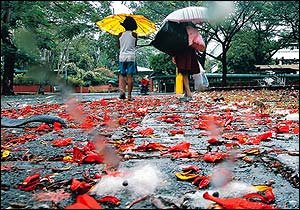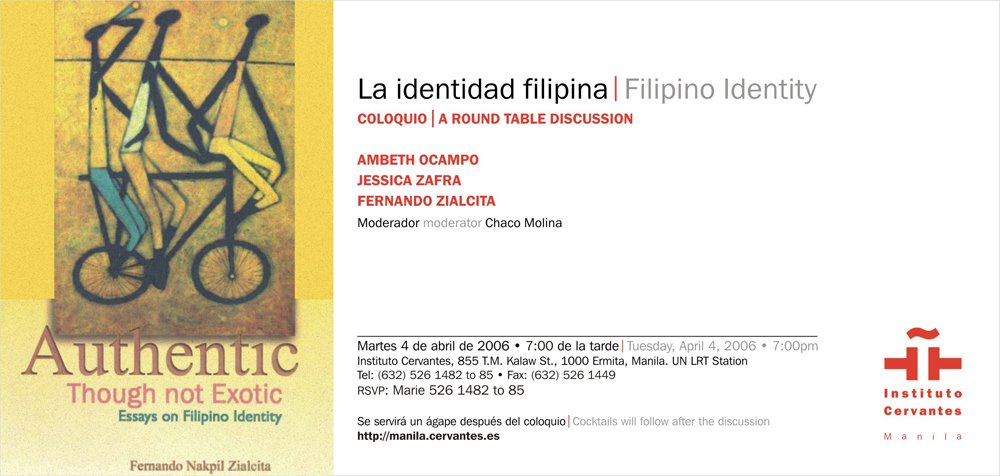Randy David has this interesting bit on
what makes artists "national":
[T]he artists the State celebrates are not necessarily the people’s own choices. Indeed, rare would be the national artist who, by his or her work, articulates the nation’s experience and self-understanding and, at the same time, touches the lives of ordinary people.
The reasons for this may be traced to the lack of fit between the nation conjured by the State and the collective identity of the people it hoped to represent. The wider the gap between the two, the larger would be the discrepancy between the nation’s symbols and the people’s heroes. Every sovereign state seeks to narrow this gap—in many instances, without much success.
Now this is particularly intriguing: "the nation conjured by the state," like it was pulled out of a top hat, and voila!
Pilipinas. Apparently, the Pilipinas that some 82 million people have in mind is not the same Pilipinas that the state has in mind. How this came to be is something that we all have to consider.
My once Imaginary/Invisible Roommate recently cleaned her side of the office and I've noticed that among her stack of books, sandwiched between Desire of Ages and a volume on igneous rocks, is something about
imagining communities.
Benedict Anderson writes in his book that what brings people together is not just a common flag, or suffering the same traffic and semi-regular revolutions in EDSA, but something we all imagined we share. He writes: "Ultimately it is this fraternity that makes it possible, over the past two centuries, for so many millions of people, not so much to kill, as willingly to die for such limited imaginings." It's actually strong enough to make you want to kill for your country, literally "ang mamatay ng dahil sa 'yo."
On a ligher scale, it's rooting for Manny Pacquiao beat somebody who brought in a professional pop artist to sing their national anthem and not squawk for the whole world to hear. For that brief moment, I'm sure that a lot of people were glued to the screens and cheered. And I'm willing to wager that more Filipinos know who Manny Pacquiao is than any of the Natinal Artists declared this year. Except perhaps for
Fernando Poe Jr. Much has been made of the mythical qualities of FPJ. In an FPJ movie, people wait for that moment when FPJ throws his rapid machine gun punches and end that barrage with a cymbal-strike on the villain's temples. It's a reassuring experience, a moment you have come to expect in every FPJ movie. He will rise and fight back. The underdog who finally musters enough courage to strike back and fight for all the little people.
But of course, in the last elections, much has also been made that the voting population might confuse the image with the man himself. There might be some truth in it: the PCIJ came out with this documentary about how most of the politicians who ran a successful presidential campaign knew
how to play out an image and get the votes. In the same way that you could never show FPJ lose in a movie or else all hell would break loose. In certain parts of the country, people pelted the cinema screens with tomatoes and slippers when their hero lost, or much worse died at the end of the movie. There was so much discontent that the producers allegedly shot an alternate ending. So even if FPJ died, there was this insert of how he ascended to the heavens while riding his horse and smiling over everything there was here on earth. That was the only way to placate the angry lot who thought they lost their hero.
Now here's the thing: FPJ has been declared National Artist, the great divide between high and pop art notwithstanding. Randy David writes: "FPJ is both a national artist and a people’s artist. He did not become great because the movie critics or the culturati liked his films. He became great because ordinary Filipinos went to his movies and were changed by them."
When people out there think of "art," with or without the "national" attached, it's usually high art. The "nation," how it is imagined by certain quarters, is supposedly different from what the people think it is. We haven't even solved what "nation" is, but the National Artist citation brings to the front and center what "culture," with the appended problemation term "national," is.
Randy David insists that the problem with this entire nation thing is that "the elite hijacked Filipino nationalism and stripped it of its social content. They became so obsessed with quickly taking over the reins of government that they did not see much value in creating a strong national identity among the people. They rushed headlong into the project of modernity, even as they paid lip service to a national culture, and promoted rapid Westernization in the end."
Westernization isn't necessarily bad, as long as it does not efface what or who we really are. We still have to figure these things out, in the same way that the controversy about who and what the National Artist is supposed to be may be endless. But was FPJ declared National Artist because the "nation" finally decided that it should not be alienated from its people, or was it done to smoothen out ruffled feathers?
The way it is now, Culture--capitalized, never in the lower case--is high culture, not pop. It is "
Ugoy ng Duyan," not "
Tulog Na." It is the highly stylized ballet Darna, not the barely-clad Angel Locsin who is torn between prioritizing public responsibility over her hectic lovelife. It is the 5 hour marathon about a murder abroad and not the laugh out loud comedy about single motherhood spiked with the essential Ate Vi compendium of cinematic dialogue. It is the strategically lit painting about dead gladiators and not the repro used in public phone cards. Culture happens in the CCP, not Broadway Centrum. But can't we have a nation that wears a barong with lawlaw jeans and "Havanas" at the same time?
Happy Independence Day everyone.















